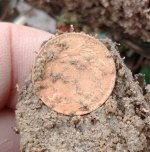gldnbrew
Full Member
- Feb 16, 2013
- 151
- 170
- Detector(s) used
-
Garrett AT Pro and ATMax, 8.5 x 11, 5 x 8 & a Super Sniper - Pro-pointer.
Fisher F75 LTD, XP Deus - 11", Garrett AT and AT ZLINK pointer
- Primary Interest:
- Relic Hunting
I am using UTM for archaeology finds (no I am not one). When I transfer (from a Garmin) the data to Google Earth the entire location is there(ex:17T 450105.93) However when I open up the properties & change the push pin color or rename it, it changes the reading by changing the numbers following the decimal point to .00 (ex:17T 450105.00). Did not do this before, the older data is OK.This is a recent development and I would like to be able to change the push pin color and rename it without losing the numbers after the decimal point.
Thank you,
Paul
P.S. I tried to manually to put the correct numbers in, but it does the same thing, rounding to the nearest whole number.
Thank you,
Paul
P.S. I tried to manually to put the correct numbers in, but it does the same thing, rounding to the nearest whole number.











